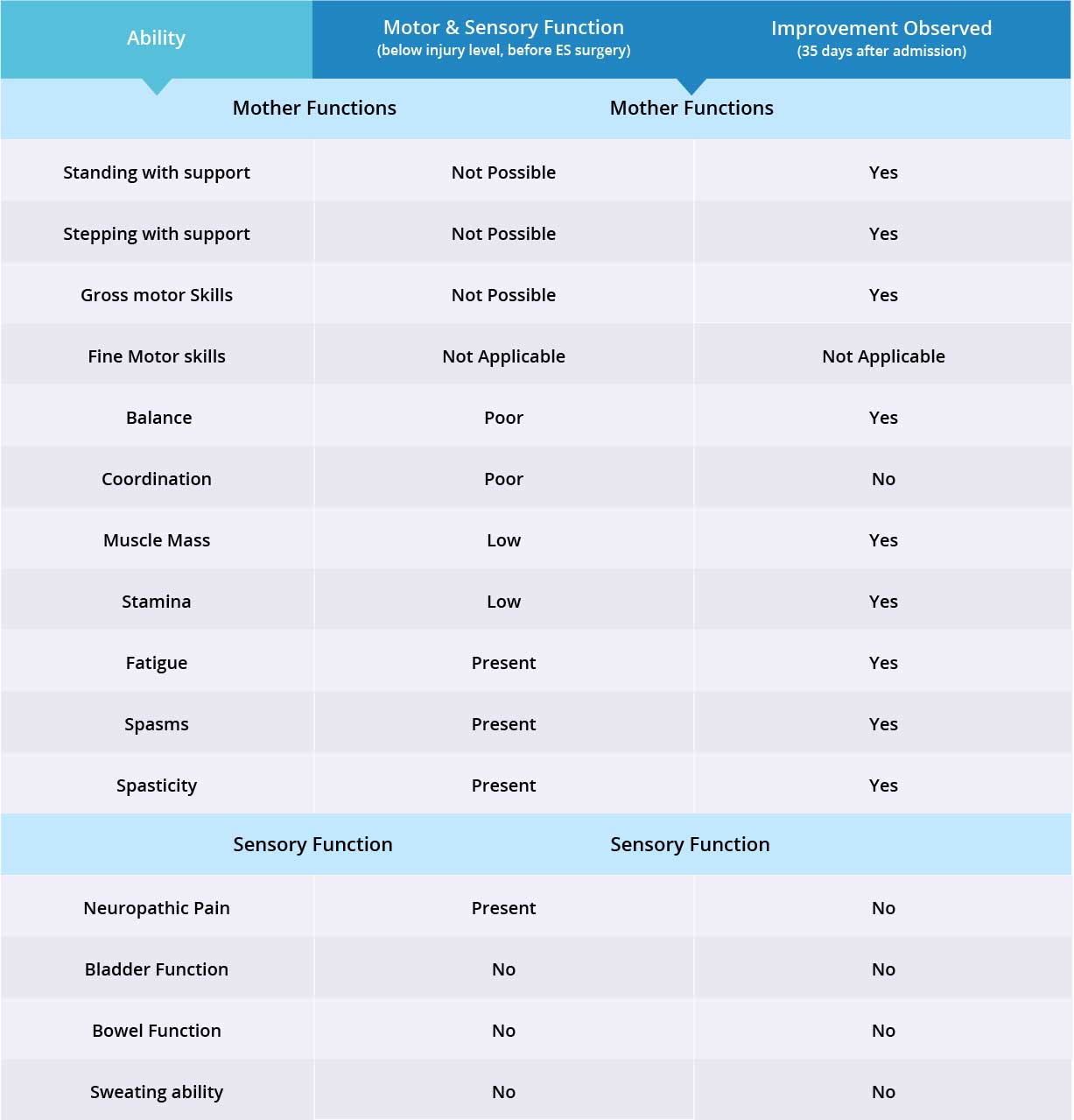This website uses cookies so that we can provide you with the best user experience possible. Cookie information is stored in your browser and performs functions such as recognising you when you return to our website and helping our team to understand which sections of the website you find most interesting and useful.
Case Study
Patient C,
Male, Malaysian
Table of Contents
Patient Overview
Age at time of treatment: 26 – 35
Injury Level: T7
Treatment Received: Stem Cells, Epidural Stimulation
Location of Treatment: Thailand
Time between injury and treatment: —
Date of Surgery: 06/08/2018
Date of Discharge: 10/09/2018
Condition on Admission
Patient sustained a T7 level traumatic SCI (spinal cord injury), resulting from a car accident in 2018. His MRI scan showed T7 fracture-dislocation with subsequent myelomalacia (softening of the spinal cord). He is paraplegic and has normal upper limb functions. Patient has minimal motor or sensory functions below the level of injury and is suffering from neurogenic bowel and bladder. He has a history of mild to moderate spasticity and suffers from moderately intense back and leg spasms. Patient does not suffer from neuropathic pain.
Previous Therapies & Treatments
N/A
Patient sustained a T7 level traumatic SCI (spinal cord injury), resulting from a car accident in 2018. His MRI scan showed T7 fracture-dislocation with subsequent myelomalacia (softening of the spinal cord). He is paraplegic and has normal upper limb functions. Patient has minimal motor or sensory functions below the level of injury and is suffering from neurogenic bowel and bladder. He has a history of mild to moderate spasticity and suffers from moderately intense back and leg spasms. Patient does not suffer from neuropathic pain.
Verita Neuro Treatment Received
After a spinal MRI scan and comprehensive blood work, patient underwent laminectomy and implantation of the epidural stimulation device on August 6, 2018. The device is the ‘Medtronic Restore Advance 16-electrode MRI Compatible Device’. The surgery was completed without issue and no complications were reported during the postoperative hospital stay. Surgical wounds healed normally and no spinal cord or superficial wound infection was reported.
After epidural stimulation surgery, patient received 100 Mapping sessions and 27 Physical Therapy sessions. Patient also received 120 million Stem cells, 40 million Mesenchymal Stem cells and 80 million Amniotic Fluid Stem Cells (hAFSCs) through one IV injection and two lumbar puncture injections, respectively. All three applications went well without adverse effects and no short-term or acute complications have been reported.
Device mapping and physical and occupational therapy were carried out after surgery for 35 days, before patient was discharged to continue physiotherapy independently at home.

Results
- Motor Functions
- Sensory Functions
- Autonomic Functions
When moving from sitting position to standing position, patient requires moderate assistance and must hold the parallel bars.
Assistance is required to lock knees while standing, however when patient uses a knee brace he is able to lock his knees himself. Patient is still unable to lock his hips while standing and requires assistance for weight bearing on both legs.
When stepping, patient is able to lift both feet and does not require any assistance in foot placement. While wearing a knee brace, patient is able to lock his knees very well during stepping, however without it patient requires assistance. Patient is not yet able to coordinate between left and right feet when taking steps.
Patient’s muscle mass has increased and endurance has improved significantly.
There was no noticeable change in bladder and bowel functions. However, with stem cell injections, we expect to see results in these areas within 3 months.

Improvements are monitored in 15 targeted areas: 11 Motor areas and 4 Sensory areas. However, the number of targeted areas may vary depending on patient’s condition prior to admission. If patient does not experience symptoms in certain Motor/Sensory functions, or is not impaired in a specific targeted area prior to surgery, it is excluded from the report (Not Applicable). If there is progress in any given area — either mild, moderate, or significant — it is measured and reported as positive (“Yes”). No improvement, the existence of pain or spasms, or an inability to perform a measured function is reported as “No”.
Results Interpretation
Patient is paraplegic with normal upper limb function, so improvement in fine motor skills was considered “Not Applicable”. Patient does not suffer from neuropathic pain therefore it was also considered “Not Applicable”. Motor function improved in 9 out of 10 targeted areas when the epidural stimulation device was switched on. Patient has not experienced any changes in sensory function, but more feedback will be collected after 3 months to note any improvements from stem cell treatment. Overall, improvements were recorded in 9 out of 13 targeted motor and sensory function areas.

